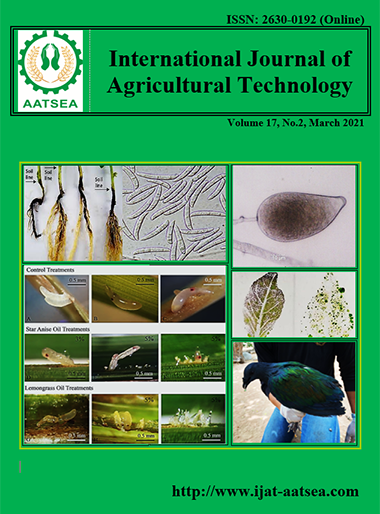A non-invasive molecular genetic technique for sex identification of Nicobar pigeon (Caloenas nicobarica), the last living relative of Dodo bird
Main Article Content
Abstract
Nicobar pigeon (Caloenas nicobarica) is the last surviving member of the genus Caloenas and the closest living relative of the extinct Dodo bird. It is classified as a near-threatened species that is illegally trapped for consumption, extraction of decorative gizzard stones, and as pets due to its size and attractive appearance. Captive breeding is essential for conservation effort and potential future commercialization of Nicobar pigeon. However, it is difficult due to the sexually-monomorphic and monogamous nature of the species. A non-invasive PCR-based technique for sex identification of Nicobar pigeon was presented here, which provided a fast and reliable method that achieves accurate results within 8 hours. Using feather samples individually obtained from captive Nicobar pigeons, results were also compared between molecular sexing method against traditional morphology-based sexing methods by vent and hackle length. However, no correlation was found between the molecular and morphological methods. Additionally, bioinformatic analysis of the amplified DNA sequence was performed for Nicobar pigeon, which showed its phylogenetic relationship with other members of the pigeon and dove family (Columbidae). This research finding is the first to show a safe, fast, and reliable method for sex identification of Caloenas bird. The proposed molecular sexing method is suitable for utilization in captive breeding program, applicable for field deployment, and potentially useful for agricultural applications
Article Details

This work is licensed under a Creative Commons Attribution-NonCommercial-NoDerivatives 4.0 International License.
References
Bermúdez-humarán, L. G., García-, A., Leal-garza, C. H. and Manuel, V. (2002). Molecular Sexing of Monomorphic Endangered Ara Birds. Journal of Experimental Zoology, 292:677-680.
BirdLife International (2016). The IUCN Red List of Threatened Species.
Boersma, P. D. and Davies, E. M. (1987). Sexing Monomorphic Birds by Vent Measurements. The Auk, 104:779-783.
Çakmak, E., Akın Pekşen, Ç. and Bilgin, C. C. (2017). Comparison of three different primer sets for sexing birds. Journal of Veterinary Diagnostic Investigation, 29:59-63.
Cerit, H. and Avanus, K. (2007). Sex identification in avian species using DNA typing methods. World's Poultry Science Journal, 63:91-99.
Ciorpac, M., Druică, R. C., Ghiorghiță, G., Cojocaru, D. and Gorgan, D. L. (2016). CHD genes : A reliable marker for bird populations and phylogenetic analysis? Case study of the superfamily Sylvioidea (Aves: Passeriformes ). Turkish Journal of Zoology, 40.
Cuervo, J. J. and Moller, A. P. (2000). Sex-limited expression of ornamental feathers in birds.
Behavioral Ecology, 11:246-259.
De Volo, S. B., Reynolds, R. T., Douglas, M. R. and Antolin, M. F. (2008). An Improved Extraction Method to Increase DNA Yield from Molted Feathers. The Condor, 110:762-766.
Ellegren, H. (1996). First gene on the avian W chrom osom e ( CHD ) provides a tag for universal sexing of non-ratite birds. Proceedings of the Royal Society B, 263:1635-1641.
Gray, G. R. (1840). A List of the Genera of Birds : with an Indication of the Typical Species of Each Genus. London: R. and J. E. Taylor.
Griffths, R., Daan, S. and Dijkstra, C. (1996). Sex identification in birds using two CHD genes. Proceedings of the Royal Society of London. Series B, 263:1251-1256.
Heupink, T. H., Van Grouw, H. and Lambert, D. M. (2014). The mysterious Spotted Green Pigeon and its relation to the Dodo and its kindred. BMC Ecology and Evolution, 14:136.
Holt, C., Campbell, M., Keays, D. A., Edelman, N., Kapusta, A., Maclary, E., Domyan, E., Suh, A., Warren, W. C., Yandell, M. et al. (2017). Improved Genome Assembly and Annotation for the Rock Pigeon (Columba livia). G3: GENES, GENOMES, GENETICS, 8:1391-1398.
Horváth, M. B., Martínez-Cruz, B., Negro, J. J., Kalmár, L. and Godoy, J. A. (2005). An overlooked DNA source for non-invasive genetic analysis in birds. Journal of Avian Biology, 36:84-88.
Jackson, B. J. S. (2006). Vent Size as an Indicator of Sex in Nesting Killdeer. North American Bird Bander, 31:157-160.
Kessel, B. (1951). Criteria for sexing and aging European Starlings. Bird-Banding, 22:16-23.
Liu, H., Li, J., Yang, F. and Cai, Y. (2011). Molecular sexing of endangered cranes based on. Journal of Applied Animal Research, 39:212-217.
Makino, S., Udagawa, T. and Yamashi ’na, Y. (1956). Karyotype Studies in Birds. 2: A Comparative Study of Chromosomes in the Columbidae. Caryologia, 8:275-293.
Shapiro, B., Sibthorpe, D., Rambaut, A., Austin, J., Wragg, G. M., Bininda-Emonds, O. R. P., Lee, P. L. M. and Cooper, A. (2002). Flight of the dodo. Science, 295:1683.
Shapiro, M. D., Kronenberg, Z., Li, C., Domyan, E. T., Pan, H., Campbell, M., Tan, H., Huff, C. D., Hu, H., Vickrey, A. I. et al. (2013). Genomic Diversity and Evolution of the Head Crest in the Rock Pigeon. Science, 339:1063-1067.
Soares, A. E. R., Novak, B. J., Haile, J., Heupink, T. H., Fjeldså, J., Gilbert, M. T. P., Poinar, H., Church, G. M. and Shapiro, B. (2016). Complete mitochondrial genomes of living and extinct pigeons revise the timing of the columbiform radiation. BMC Ecology and Evolution, 16:1-9.
St. John, J. and Quinn, T. W. (1998). Chromosome-Specific Intron Size Differences in the Avian CHD Gene Provide an Efficient Method for Sex Identification in Birds. The Auk, 115:1074-1078.
Stringham, S. A., Mulroy, E. E., Xing, J., Record, D., Guernsey, M. W., Aldenhoven, J. T., Osborne, E. J. and Shapiro, M. D. (2012). Divergence, convergence, and the ancestry of feral populations in the domestic rock pigeon. Current Biology, 22:302-308.
Totterman, S. L. (2015). A comparative evaluation of four field methods for sexing wedge-tailed shearwaters PUFFINUS PACIFICUS. Marine Ornithology, 43:83-93.


